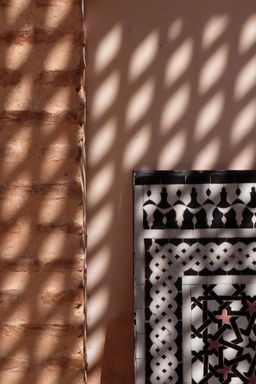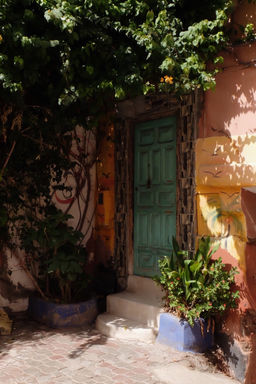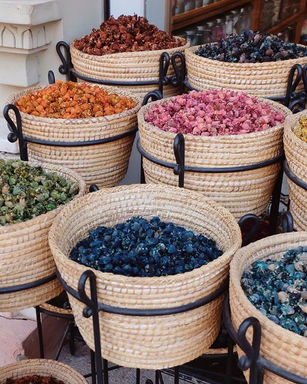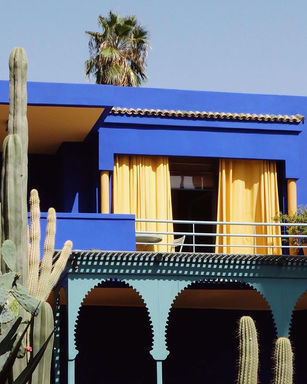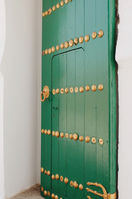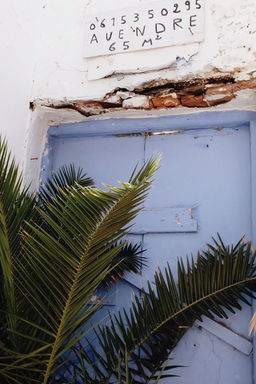ALESSANDRA MUSE
MARRAKECH, MOROCCO - The Red City
One of the most captivating things about Morocco, and especially Marrakech, is the level of artistry and craftsmanship of products made and sold here. Marrakech is a true designer's city - with a fabulous mixture of modern and traditional style. The city is most notably recognized as the second home of French luxury designer, Yves Saint Laurent. The YSL museum and gardens are one of the largest tourist attractions here, and certainly worth a visit.
Musee de Louvre is perfect for the fashion history lover. The museum is very strict with a rule of no pictures allowed inside the costume room - but it's not impossible to snag some shots (see a few below). Le Jardin Majorelle is the other half of the complex, and this is where I spent more time. The garden is unlike any other - and I mean that, because there's nothing more boring than visiting another botanical garden in every new city. The garden is probably the most tourist-packed location in Marrakech, but still enjoyable. There's also enough desert landscaping, ponds, pottery and colored walls to go around. This is where I got into a little trouble with my friends... I tend to linger to take photos and sometimes get separated from the group.
*Note: On the topic of safety, Marrakech and Morocco in general are not known to be the safest for women or western travelers. That being said, during daylight hours and in most areas of the city I felt completely safe. Like I said, I continually wandered away from my group to take photos and didn't feel like a target of any kind. There are a few things that could be a determining factor for female safety here (and most other parts of the world) that I try to stick to:
-
Travel in groups - and it doesn’t hurt to have at least one male in the group. Having visited Morocco twice, once without men, I felt a significant difference in overall comfort and treatment in the streets.
-
Wear modest clothing - a lot of women visit Marrakech and wear western style clothing like shorts and crop tops because the city is modern and known for fashion, however, locals don't really dress that way for the most part. I find it always helpful to try and blend in with locals while traveling. It helps with restaurant and cab service, street conversation, shopping/bartering and certainly safety. Even if you dress modestly, there's no doubt you will still stand out here, and as a female, will receive attention (unwanted and perverted at times). If you can, keep your thighs and stomach covered.
-
Make the most of daylight hours - and avoid exploring at night. Walking after dark with a male present is a hard rule of mine, and even with men, I keep it to a minimum. In the evening, we went to restaurants and bars in the newer part of town and took cabs there and back.
During our time in Marrakech, we spent a lot of time strolling, sightseeing and shopping. There is definitely enough to do of each, if one isn’t your thing.
One thing I can distinguish about Marrakech that differs significantly from most other famed cities is the relaxed feel at tourist and historical sites. Even while doing Trip Advisor's Top 5 Things to See in Marrakech, you almost feel like a local. I think it has something to do with the lack of large crowds, ticket lines, corny guided tours and things like that. For me, this made touring historical sites seem much more authentic, memorable and easier to photograph.
Sightseeing:
-
El Badi Palace - captivating site in the center of the city with ruins that date back to the 16th century. Not much is left of what it used to be, but it's easy enough to imagine the serenity of the minimalist Moorish design, with warm color schemes and indoor/outdoor spaces connected by turquoise pools.
-
Saadian Tombs - quite romantic for a gravesite, with rose bushes, shaded nooks, and white detailing. We spent about half an hour sitting in the shade watching a tilemaker carve sample pieces for tourists. I took a few tiles home that still sit on my dresser.
Shopping areas:
-
Gueliz - modern arts district of Marrakech with upscale shopping near the YSL gardens. Best area for modern shopping that still has the Moroccan influence and quality. There are just a handful of boutiques side by side but they have the most interesting selections of pottery, decor, photography, art, clothing, jewelry, and accessories..... the prices are also fairly reasonable. Our favorite shop was 33 Rue Majorelle.
-
Old Medina - best shopping area for traditional tourist items and trinkets. Bartering is key - and most shops have the same items. If you find something you like and don't love the price or quality, keep looking. If you find something you love, buy it. You might not remember how to get back there later. The best shops and boutiques in the Old City are near Le Jardin Secret - this area is more sophisticated and caters to visitors of the chic secret garden.
The Old Medina is a perfect place for sightseeing, shopping and strolling - there's no doubt. Our airbnb was in the heart of the Old City, just a 5 minute walk from the popular souks. I firmly believe everyone's first time in Marrakech should include a stay in a traditional riad. The experience is a must, before the villas and hotels, and is especially fun for groups. Riads are traditional Moorish homes with indoor/outdoor designs that feature a central courtyard. The idea of the riad became popular as a way to escape the chaos of the village sounds and busy streets. They were built to provide sanctuary and serenity deep in the confusion of the Old City.
Our riad was three stories. On the ground floor was a kitchen, dining room and lounge spaces surrounding a pool. Bedrooms were on the second floor, and the third featured a rooftop and lounge space. We received so much extra care that was included in our airbnb reservation. A sweet local woman made us Moroccan breakfast each morning, with fruits and juices, an assortment of Moroccan breads and jams. We had a live-in concierge/butler/babysitter named Camel, who stocked our fridge with our daily requests and served us mint tea by the pool in the afternoons. Camel explained to us that most rental properties in Marrakech include a live-in watchdog of sorts to prevent illegal activity from occurring. At first, we were a little confused and annoyed at this, since there was no mention of this on our reservation. Later, however, we realized it was really helpful to get advice about the city, dining and other things at basically a ring of a bell. And Camel turned out to be a young local art student - he bonded with the boys and we spent most afternoons hanging out with him by a hookah.
The riads are also generally only available in the Old City, which is the perfect location to experience Marrakech for the first time. Everything about this area of town is exactly what you picture of a storybook Marrakech. The Old City still has a protective wall around it that keeps it separate from the rest of Marrakech. In some ways, the wall seems to have allowed it to keep its original character. Its heritage and village culture is so well preserved, with the smallest of alleyways and largest outdoor markets. The newest live action Aladdin movie was filmed in Marrakech, and it is such a true representation of the city even today. I swear they didn't have to put very much of the Disney sparkle on it. What you don't see, however, you smell. There is a slight sewage smell in the streets. That's the least magical part of the city, but it's quite tolerable and expected. The other issue is safety. In the older and poorer part of Marrakech, and any city for that matter, I try to avoid areas without crowds or tourists. Although our week here was incident-free, it's important to stay cautious and avoid areas that just don't feel as safe - especially as a female and after dark. That being said, there is so much more charm and inviting neighborhoods in Marrakech than 'sketchy' areas, and the city and country are truly magical.
NORTHERN MOROCCO & CHEFCHAOUEN - The Blue City
The lesser known region of Northern Morocco is home to beachside art and surf towns surrounded by rolling green hills and jungle. It is also easily accessible from Europe. I visited Morocco for the first time while living in Spain, and took a short ferry ride from Tarifa across the Strait of Gibraltar to Tangier, a large coastal city in Morocco.
Tangier is a great starting point in the north, and if you're planning to stay in nicer hotels, it is a good location to keep as a home base. This is not necessarily the best way to go, but how I experienced it in an organized group for the first time.
Note: I am not a proponent for organized travel experiences. I do understand the appeal... It works for those that are too busy to build itineraries and make reservations. It can feel safer, more secure and trusted. It can sometimes appear cheaper (to see less zeros guaranteed as your end total). In reality, it can be just as easy to meet those low travel totals or even lower while traveling independently if you just stick to your plan and stay disciplined with your spending from start to finish. Even more so, travel is so much more rewarding with freedom to choose each of your experiences and mold a destination into your own.
Tangier happens to be fairly close (3 or 4 hours) from the Pinterest-esque location of Chefchaouen - also known as the "Blue City." Chefchaouen is the most charming village in Morocco (at least that I've seen so far.) I can't imagine it gets any better, though, for the avid local village traveler. The village is still as local-feeling as can be despite its famous blue alleyways plastered over every travel platform, which I think is remarkable and incredibly refreshing. I visited about 4 years ago, so things may have changed since and the city may have become more touristy - but I hope not! To see a place with iconic and infamous imagery that is still for the most part untouched and not commercialized does not happen very often. During my tour of Chefchaouen, there were quite literally no other tourists, no westerners, no chain hotels or restaurants and no organized tourist attractions. Women sold crafted goods and trinkets in the streets and quiet men lounged around the entrances of their shops - all without the aggressive coaxing and hustling of larger cities. Chefchaouen is also notably clean, with not much chaos, animals or waste in the streets, despite the poverty of the rural area. The town itself is pretty small and can be accomplished in half a day. I did not stay overnight, and I don't know much about options for staying in town. I would imagine the options are slim and not up to a westerner's standards. If you are more of a comfort traveler (at least when it comes to where you sleep) I would recommend staying in a nearby city such as Tangier that has plenty of 3-5 star hotels.
From Tangier, I also visited the seaside town of Asilah, which was the best surprise. This village is a Moroccan take on the white-washed Cycladic Islands in Greece and a Southwestern Africa artist's village. The village is extremely vibrant and lively. Alone the boardwalk area, which is cliffside above the coastline, were tribal-dressed street performers and drummers making music and showing off traditional dancing. In the center of town, every building was bright white, with pops of green, red, and blue at every doorway, arch, mural and tapestry. Each mural had a message of world peace, which was a moral theme for this town that could be felt. The jewel tone palette against stark white is something I hadn't seen before and have yet to see since. The artistry and positivity of Asilah really did radiate through its streets and made my time in Northern Morocco most memorable.
PREPARING FOR MOROCCO
Morocco has a unique location since it is so close to Southern Europe. This proximity makes it a much easier destination for some, and for others, it can easily be added on to a leg of a longer European tour.
Budgeting for airfare is the most important, and there are a number of affordable options that fly direct to Marrakech from the U.S., or through major cities in Southern Europe such as Barcelona and Rome. Beyond airfare, hotels, villas and riads are moderately priced, with riads and villas being cheapest (and most fun) for larger groups. Daily expenses like food and cabs are quite cheap. Activities such as desert tours, camping experiences, jeep rides and so on are more of a splurge and important to factor into an overall budget. Once you have those numbers in mind, the hard part is making sure you stick to them!
Eat in the modern areas of Marrakech - especially if you'd like to try more than just couscous and tagine. The restaurants near Gueliz have the best international food and upscale dining/lounge experiences.
LA TRATTORIA
Gueliz
Marrakech,Morocco
AMAIA
Gueliz
Marrakech, Morocco
Opt for the traditional riad in the Old City. It will be most memorable and it is the perfect sanctuary after a day in the streets of Marrakech. Try to get one with a pool if visiting in the summer!
MOROCCO
Morocco is one of my passion destinations. I have so far visited twice, and I hope to visit again, stay in a quiet riad and stroll through alleyways for artisan work to fill my home. It's almost difficult to travel elsewhere. Morocco is a destination for the artist, the architect, and all those creative.
Keep reading for more on my time in Morocco, including tested do's and don'ts, pertinent information for first timers, tips for budgeting and a complete cultural guide for restaurants, hotels, sights and more.








